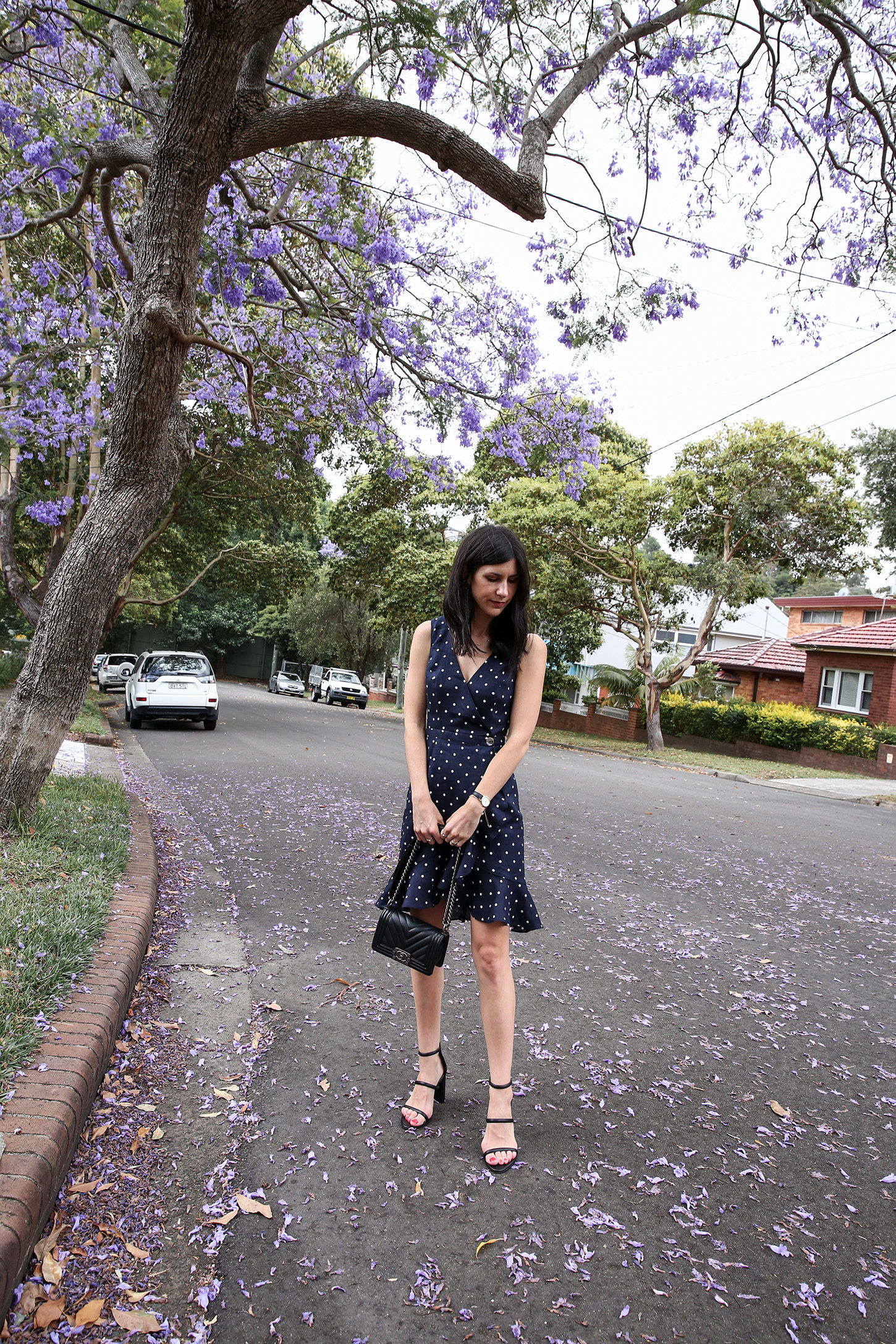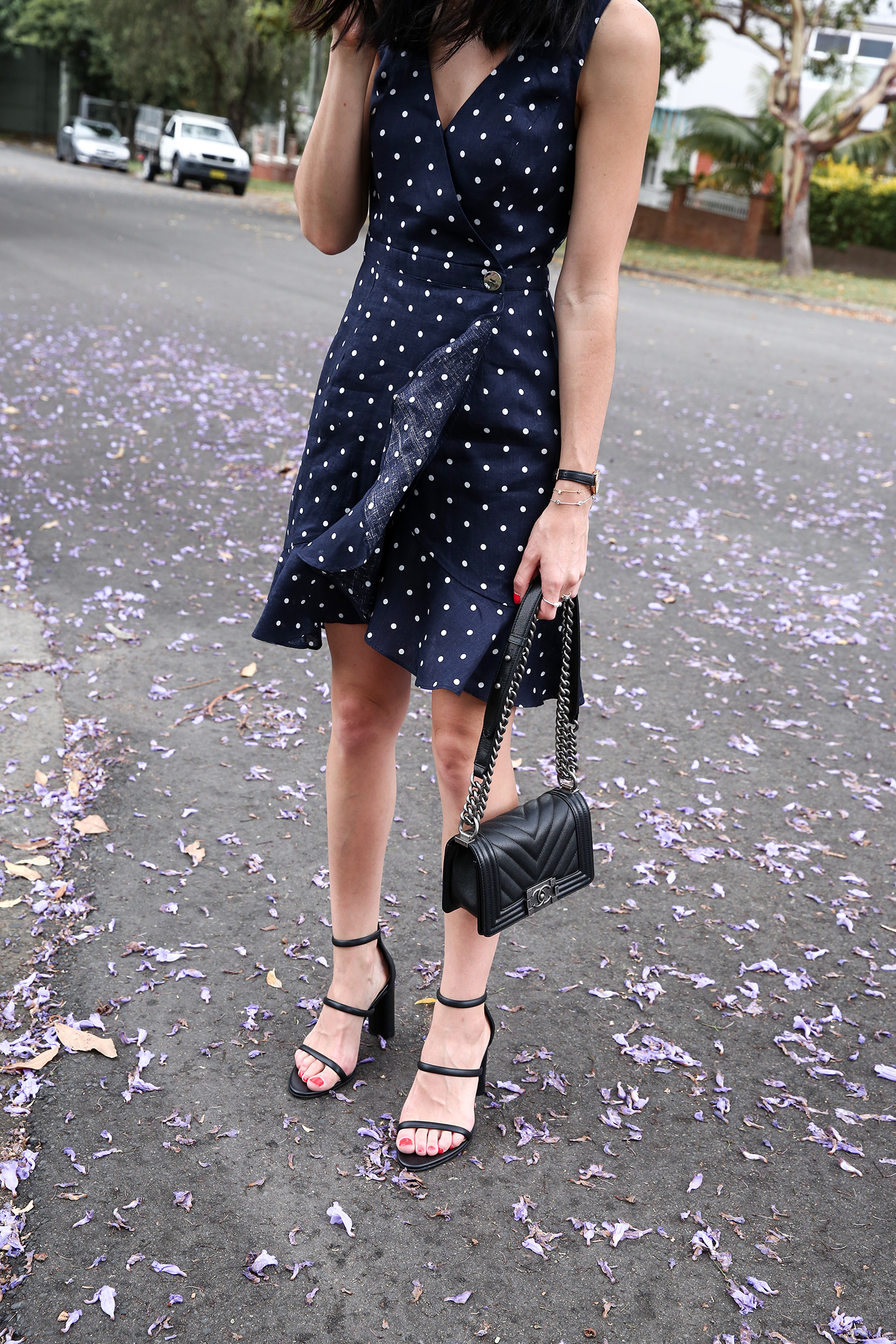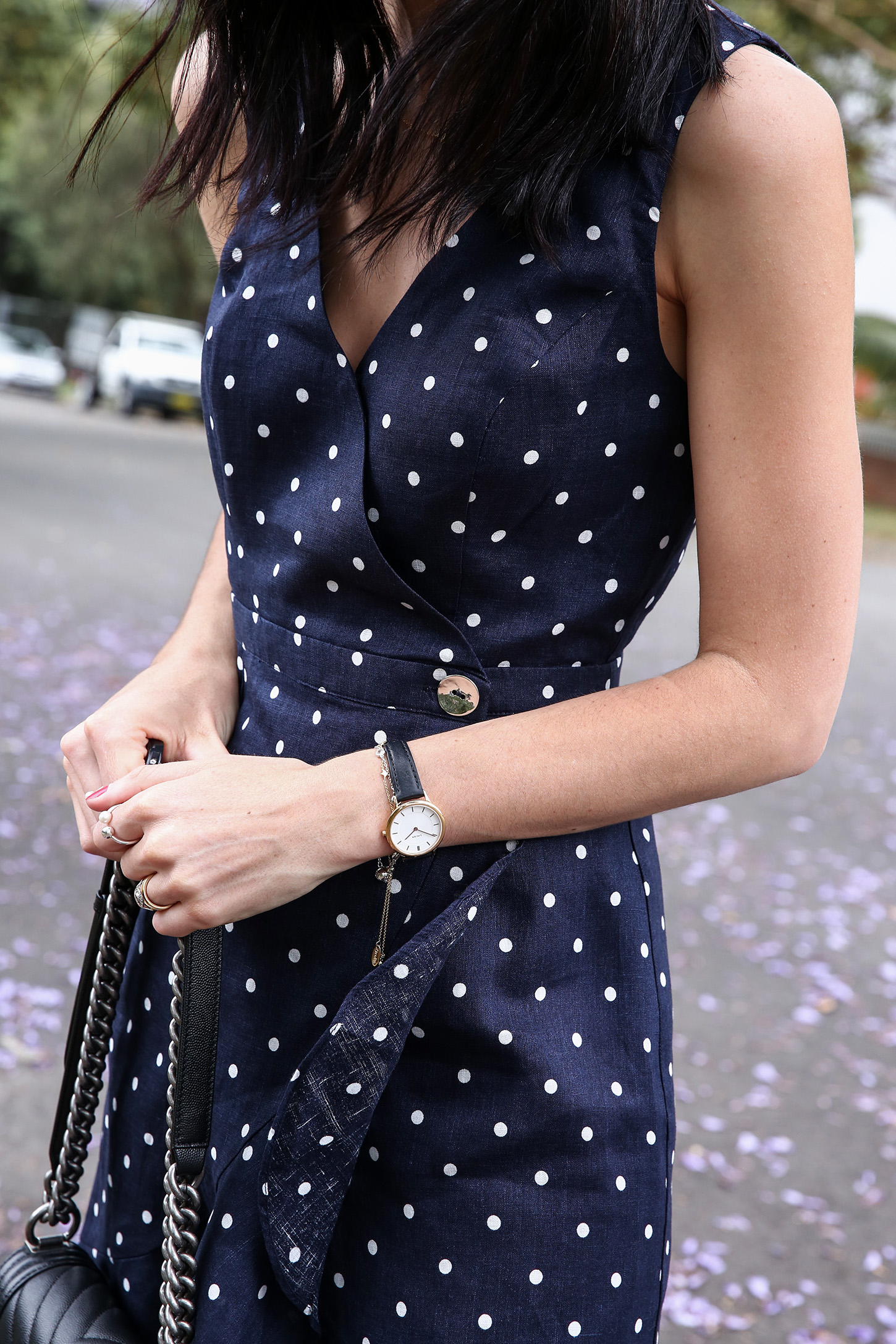


The first thing that probably comes to mind when thinking about shopping sustainably are natural fibres. Shifting that mindset away from buying man-made fibres (which is having a negative on the environment), and investing in quality materials is what I would consider to be a good starting block, especially if you’re only just beginning to transition your wardrobe to make it more sustainable in the long run. Perhaps more specifically, I’d say we look to cotton. Cotton basics are sold in abundance; our every day tees are made of cotton, the denim we reach for on repeat are made of cotton, and it’s likely you have a cotton sweater, shirt or dress tucked away in your closet too. And while I think cotton – and in particular organic GOTS-certified cotton – garments are not only versatile but will keep you cool during the warmer months, there’s a natural fibre which has a much lower environmental impact, and is far more durable; linen.
Wearing Portmans polka dot linen dress, Jo Mercer heels, Chanel boy bag, Missoma necklace, Mejuri earrings, Linjer watch, Orelia bracelet, Swarovski bracelet, Pandora pearl ring
My love affair with linen started before I even hit my teens. I was 11 years old, and about to embark on a three week camp in Greece during the summer. It was a happy coincidence, but I’d found some stone and lime green (!!) linen fabrics at Spotlight, which I had sewn into a couple pairs of shorts by my Yiaya. And I’d say I’ve been very forthcoming about how much I love to be able to incorporate linen textures into my wardrobe even now. As I’ve become more aware of issues regarding the ethics and sustainability practices of the garment industry, I’ve also learned more about the fibres that I’m wearing.
We seldom question where our clothes come from, and even less so the qualities of the fabrics we’re wearing, beyond whether it keeps us ‘cool’ or ‘warm’. So today I wanted to put the focus on linen. Where it comes from, the history of using it as a fabric for garment production, and how linen is a more sustainable choice than cotton.
The history of linen
Linen is a fibre that we’ve been using for more than 10,000 years. The fibre is spun from the stems of the flax plant, which in itself is hugely versatile; all of its parts can be used for something – whether that is soap, oils, paper, or cattle feed – meaning that no waste is created during the production process. It was hailed for its durability and versatility, with many linen items in the home handed down from generation to generation.
Originating in the Middle East, it was used by Egyptians as currency and was also used to wrap mummies before they were laid in their tombs. During Medieval times in Europe, linen was popularly used to produce clothing, sacks, sheets, fishing nets bags and more, and it was widely believed that the flowers protected against witchcraft and black magic.
How is linen produced?
Linen is a fabric that is derived from the flax plant, and it’s worth noting as I mentioned above, that all parts of the plant are used to create worthwhile products, which makes production not only cost-effective, but it means that nothing is wasted.
The flax plant is resilient. It can grow in poor quality soil, consumes far less water than is traditionally used in cotton production, and less pesticides during the growth stages too. To create the fabric, linen yarn is spun from the fibres found in the stems of the flax plant, and woven into the textile that we call linen.
Production of organic cotton requires huge acreage, as the yield is lower than in traditional cotton farming due to the lack of chemicals allowed during this growth phase. And then there’s the drain on resources; 2,700 litres of water are required to produce the cotton to make one simple t-shirt.
While the stats aren’t quite as common on the resources required to produce linen, from what I’ve gathered, the cultivation of the flax plant to maturity uses approximately four to seven times less the amount of water used in cotton manufacturing.
Plus it’s worth noting that linen can be processed without the use of chemicals, and it biodegrades without creating harmful waste at the end of its useful life. To me, this is the epitome of a sustainable textile, and the reason why I’m so quick to spring for a linen piece over cotton.




Why linen?
There’s a lot of great qualities to really love when it comes to linen clothing. First, it regulates temperature extremely efficiently, with research showing that you’ll generally perspire less when wearing linen rather than cotton fibres, due to its natural ability to wick moisture away from your body.
The texture of linen is unique; it has a lot of depth which gives it an interesting appearance, while the hand-feel of the fibre is soft to the touch. I think it’s a great option if your clothing is at risk of being moth-eaten, as linen is both moth-resistant and anti-microbial, and I love that linen textiles biodegrade leaving behind no waste at the end of their natural life.
While it might crumple up a bit in your suitcase, it is also a great option to take when travelling. It’s lightweight, which means it won’t add much bulk to the overall weight of your suitcase, and it dries quickly too.
Each time you launder a linen piece, it’ll soften more and more, while still retaining its resilience as the fabric is woven tightly. Essentially, it seems to really just get better with age.
Final thoughts
Sometimes I think linen gets a bit of a bad rap. Sure, it wrinkles easily, but that’s also a huge part of the charm. There’s a real lived-in look to the textile which only comes as it ages, and it’s one of the qualities that I find most attractive about linen.
I also like that it keeps me cool. Living in Sydney, I’ve become accustomed to summers which regularly sees days hitting highs of close to (or over) 40 degrees celsius. So, anything that’s going to help regulate my temperature, and wick away some of that moisture is a winner in my books. I mean, it’s hard to look chic while trying to keep cool, but I always feel like my outfits are put together and effortless when I’m wearing a linen piece.
Do you like wearing linen? And if not, why? I’d love to hear your thoughts in the comments section below x


I always forget about linen but it really is a great fabric! I’ll definitely have to try and add more pieces to my wardrobe instead of cotton.
I also get tired of having armpit stains on my cotton tees, maybe linen would help alleviate that, ha ha.
https://www.closet-fashionista.com/
Hi, I really enjoyed your article. I also love linen and don’t mind ironing it or that it creases. I always look at what fabric things are before I buy them. In France and I think they had communal areas where they grew hemp also, it’s a very similar (but coarser – very hard wearing) fabric. Last summer I purchased a shirt made from ramie – looks like linen, I googled it, it grows in India and China and has long fibres. It said it’s not as durable. I love fabrics.